X-ray Imaging and Computed Tomography for the Identification of Geometry and Construction Elements in the Structure of Old Violins
Abstract
:1. Introduction
2. Materials and Methods
2.1. Studied Structures
2.2. Methods
2.2.1. Wood Structure Data Acquisition
2.2.2. X-ray Imaging
2.2.3. Computed Tomography
2.2.4. Data Processing
3. Results and Discussions
3.1. The Anatomical Analysis of Wood from the Construction of Old Violins
3.2. X-ray Radiography of Heritage Violins
3.3. Imaging Analysis of Old Violins Using CT Scanning
4. Conclusions
Author Contributions
Funding
Institutional Review Board Statement
Informed Consent Statement
Data Availability Statement
Acknowledgments
Conflicts of Interest
References
- Tai, H.-C.; Shen, Y.-P.; Lin, J.-H.; Chung, D.-T. Acoustic evolution of old Italian violins from Amati to Stradivari. Proc. Natl. Acad. Sci. USA 2018, 115, 5926–5931. [Google Scholar] [CrossRef] [Green Version]
- Sandu, I.C.A.; Negru, I.C.; Sandu, A.V.; Vasilache, V. Authentication of an Old Violin by Multianalytical Methods. Appl. Sci. 2020, 10, 306. [Google Scholar] [CrossRef] [Green Version]
- Lämmlein, S.L.; Mannes, D.; Van Damme, B.; Schwarze, F.W.; Burgert, I. The influence of multi-layered varnishes on moisture protection and vibrational properties of violin wood. Sci. Rep. 2019, 9, 18611. [Google Scholar] [CrossRef]
- Rigon, L.; Vallazza, E.; Arfelli, F.; Longo, R.; Dreossi, D.; Bergamaschi, A.; Schmitt, B.; Chen, R.; Cova, M.A.; Perabò, R.; et al. Synchrotron-radiation microtomography for the non-destructive structural evaluation of bowed stringed instruments. E-Preserv. Sci. 2010, 7, 71–77. [Google Scholar]
- Erdélyi, S. Hungarian Treasures of Violinists; DRESKULT: Budapest, Hungary, 1997; (In English and Hungary). [Google Scholar]
- Schwarze, F.W.M.R.; Morris, H. Banishing the myths and dogmas surrounding the biotech Stradivarius. Plants People Planet 2020, 2, 237–243. [Google Scholar] [CrossRef] [Green Version]
- Čufar, K.; Beuting, M.; Demšar, B.; Merela, M. Dating of violins—The interpretation of dendrochronological reports. J. Cult. Herit. 2017, 27, S44–S54. [Google Scholar] [CrossRef]
- Klein, P.; Mehringer, H.; Bauch, J. Dendrochronological and wood biological investigations on string instruments. Holzforsch. Int. J. Biol. Chem. Phys. Technol. Wood 1986, 197–203, 197–203. [Google Scholar] [CrossRef]
- Klein, P.; Pollens, S. The Technique of Dendrochronology as Applied to Violins Made by Giuseppe Guarneri del Gesù; Biddulph Publisher, Giuseppe Guarneridel Gesù: London, UK, 1998. [Google Scholar]
- Topham, J.; McCormick, D. A dendrochronological investigation of British stringed instruments of the violin family. J. Archaeol. Sci. 1998, 25, 1149–1157. [Google Scholar] [CrossRef]
- Topham, J.; McCormick, D. A dendrochronological investigation of stringed instruments of the cremonese school (1666–1757) including “The Messiah” violin attributed to Antonio Stradivari. J. Archaeol. Sci. 2000, 27, 183–192. [Google Scholar] [CrossRef]
- Le Conte, S.; Le Moyne, S.; Ollivier, F. Modal analysis comparison of two violins made by A. Stradivari. In Proceedings of the Acoustics 2012 Nantes Conference, Nantes, France, 23–27 April 2012. hal-00811010. [Google Scholar]
- Fiocco, G.; Gonzalez, S.; Invernizzi, C.; Rovetta, T.; Albano, M.; Dondi, P.; Licchelli, M.; Antonacci, F.; Malagodi, M. Compositional and Morphological Comparison among Three Coeval Violins Made by Giuseppe Guarneri “del Gesù” in 1734. Coatings 2021, 11, 884. [Google Scholar] [CrossRef]
- Lehmann, E.H.; Mannes, D. Wood investigations by means of radiation transmission techniques. J. Cult. Herit. 2012, 13, S35–S43. [Google Scholar] [CrossRef]
- Stoel, B.C.; Borman, T.M. A Comparison of Wood Density between Classical Cremonese and Modern Violins. PLoS ONE 2008, 3, e2554. [Google Scholar] [CrossRef] [Green Version]
- Nia, H.T.; Jain, A.D.; Liu, Y.; Alam, M.R.; Barnas, R.; Makris, N.C. The evolution of air resonance power efficiency in the violin and its ancestors. Proc. Math. Phys. Eng. Sci. 2015, 471, 20140905. [Google Scholar] [CrossRef] [Green Version]
- Cattani, C.; Dunbar, R.L.M.; Shapira, Z. Value Creation and Knowledge Loss: The Case of Cremonese Stringed Instruments. Organ. Sci. 2012, 24, 813–830. [Google Scholar] [CrossRef]
- Marcon, B.; Goli, G.; Fioravanti, M. Modelling wooden cultural heritage. The need to consider each artefact as unique as illustrated by the Cannone violin. Herit. Sci. 2020, 8, 24. [Google Scholar] [CrossRef]
- Sodini, N.; Dreossi, D.; Chen, R.; Fioravanti, M. Non-invasive microstructural analysis of bowed stringed instruments with synchrotron radiation X-ray microtomography. J. Cult. Herit. 2012, 13, S44–S49. [Google Scholar] [CrossRef]
- Nyman, C.D. 1. History of the Development of the Violin 2. Construction of the Violin 3. Repairs of the Violin String Instruments. Master’s Thesis, Utah State University, Logan, UT, USA, 1975; p. 750. Available online: https://digitalcommons.usu.edu/gradreports/750 (accessed on 15 June 2021).
- Blümich, B.; Baias, M.; Rehorn, C.; Gabrielli, V.; Jaschtschuk, D.; Harrison, C.; Invernizzi, C.; Malagodi, M. Comparison of historical violins by non-destructive MRI depth profiling. Microchem. J. 2020, 158, 105219. [Google Scholar] [CrossRef]
- Hargrave, R. A Violin by Jacobus Stainer. 1679. Available online: https://www.roger-hargrave.de/PDF/Artikel/Strad/Artikel_1987_09_Jacobus_Stainer_1697_PDF.pdf (accessed on 15 June 2021).
- Dinulică, F.; Albu, C.; Borz, S.A.; Vasilescu, M.M.; Petrițan, C. Specific structural indexes for resonance Norway spruce wood used for violin manufacturing. Bioresources 2015, 10, 7525–7543. [Google Scholar] [CrossRef]
- Dinulică, F.; Albu, C.T.; Vasilescu, M.M.; Stanciu, M.D. Bark features for identifying resonance spruce standing timber. Forests 2019, 10, 799. [Google Scholar] [CrossRef] [Green Version]
- Dinulică, F.; Stanciu, M.D.; Savin, A. Correlation between anatomical grading and acoustic–elastic properties of resonant spruce wood used for musical instruments. Forests 2021, 12, 1122. [Google Scholar] [CrossRef]
- Pilcher, J.R. Sample preparation, cross-dating and measurement. In Methods of Dendrochronology; Cook, E.R., Kairiukstis, L.A., Eds.; Kluwer Academis Publishing: Dordrecht, The Netherlands, 1990; pp. 40–51. [Google Scholar]
- Zar, J.H. Biostatistical Analysis; Prentice-Hall Inc.: Englewood Cliffs, UK, 1974. [Google Scholar]
- Rocaboy, F.; Bucur, V. About the physical properties of wood of twentieth century violins. J. Acoust. Soc. Am. 1990, 1, 21–28. [Google Scholar]
- Bucur, V. Acoustics of Wood, 2nd ed.; Springer: Berlin/Heidelberg, Germany, 2006; pp. 173–196. [Google Scholar]
- Mannes, D.; Lehmann, E.; Niemz, P. Tomographic investigations of wood from macroscopic to microscopic scale. Wood Res. 2009, 54, 33–44. [Google Scholar]
- Bissinger, G. Structural Acoustics of Good and Bad Violins. J. Acoust. Soc. Am. 2008, 124, 1764–1773. [Google Scholar] [CrossRef]
- Kasal, B.; Adams, A.; Drdácký, M. New applications in radiographic evaluation of structural components. Eur. J. Environ. Civ. Eng. 2010, 14, 395–410. [Google Scholar] [CrossRef]
- Hýsek, Š.; Löwe, R.; Turcáni, M. What Happens to Wood after a Tree Is Attacked by a Bark Beetle? Forests 2021, 12, 1163. [Google Scholar] [CrossRef]
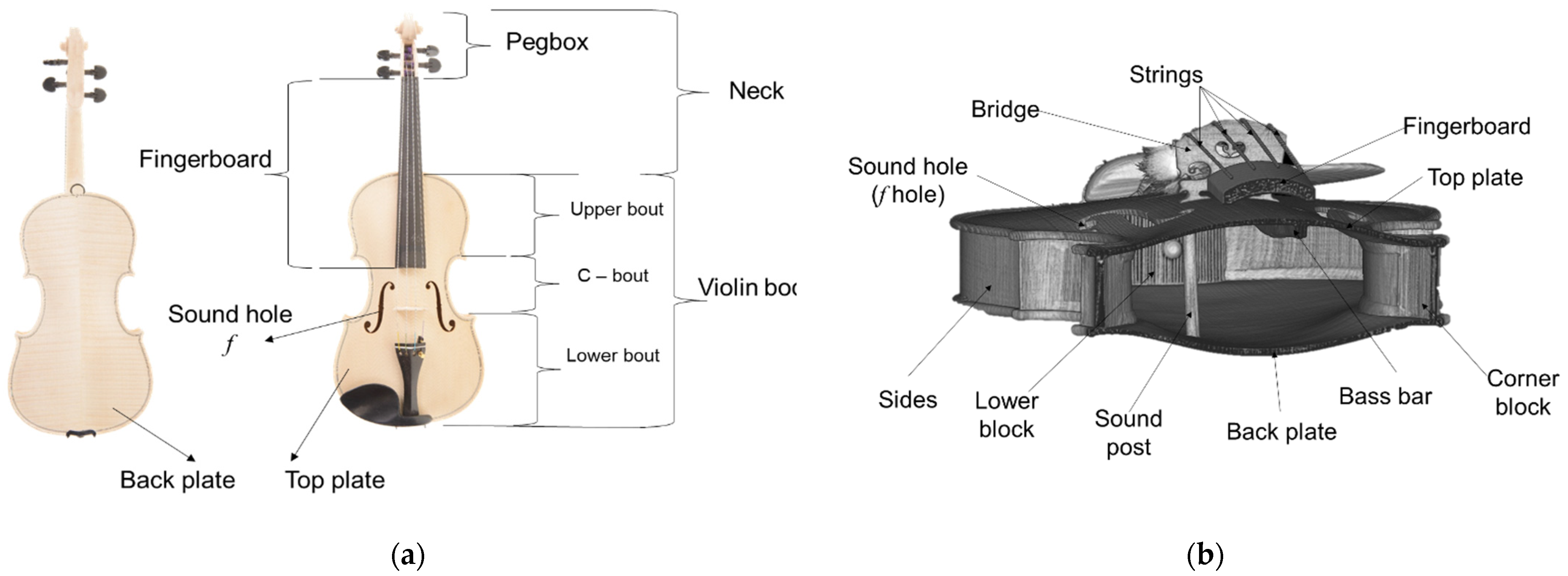
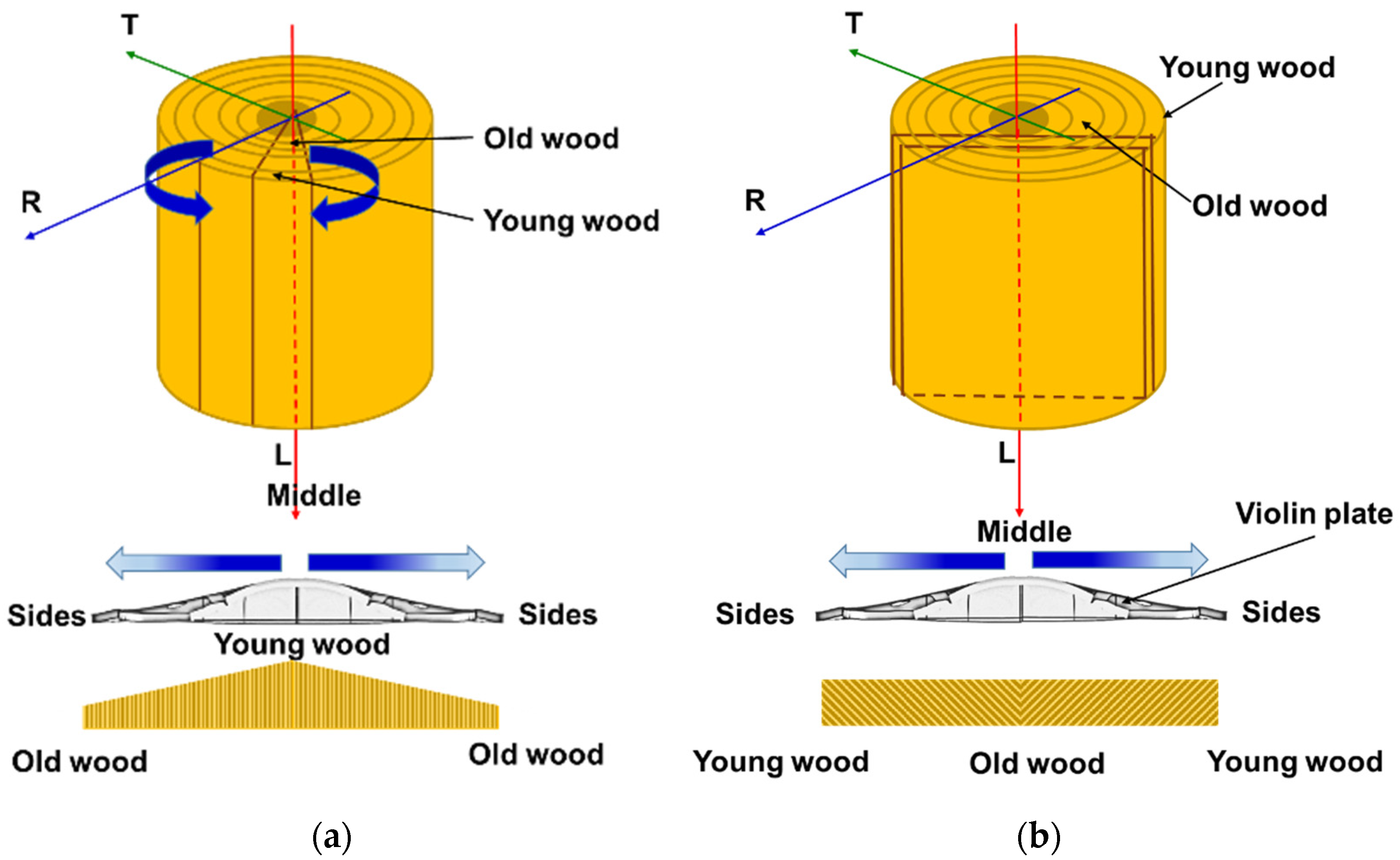
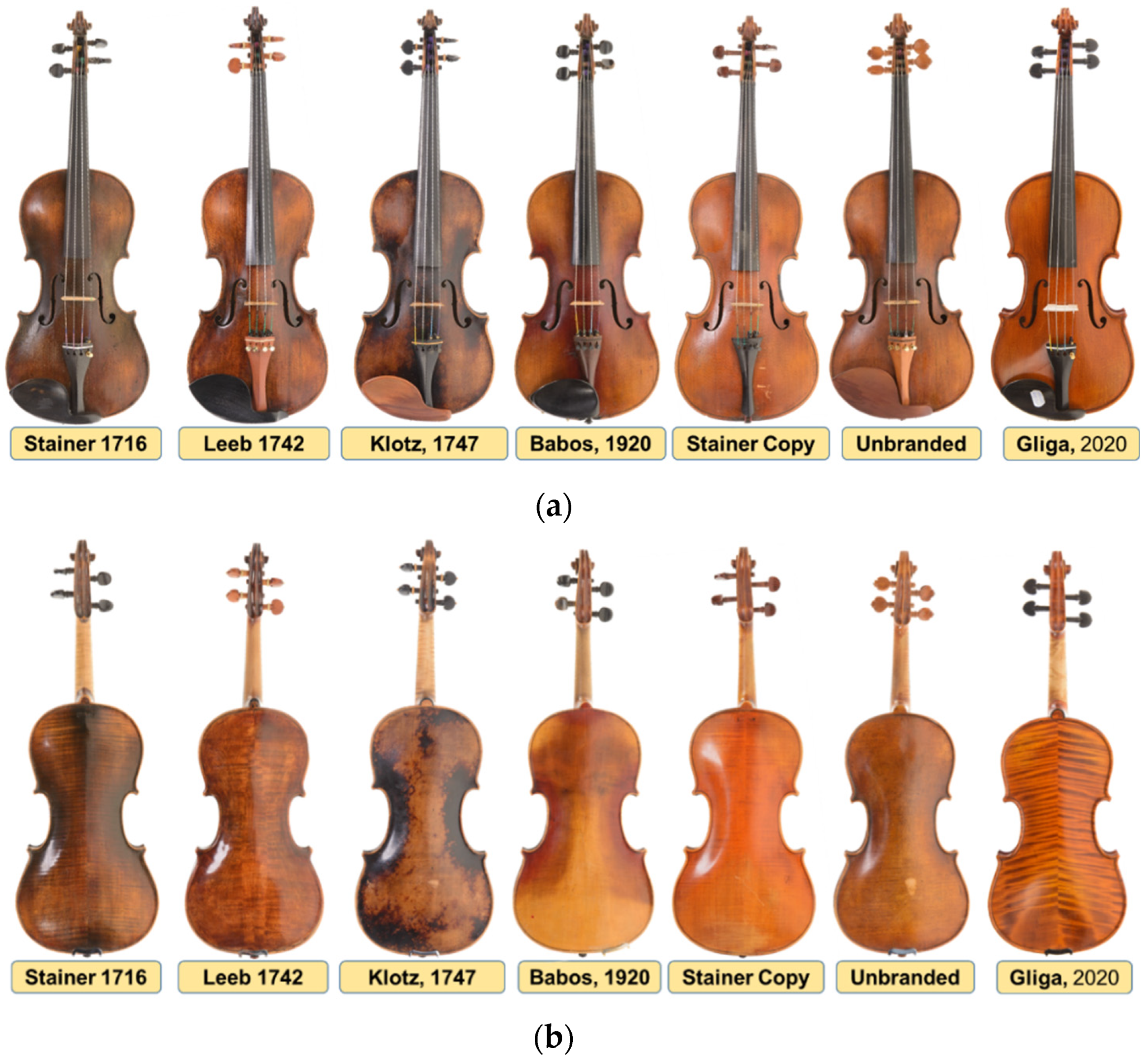
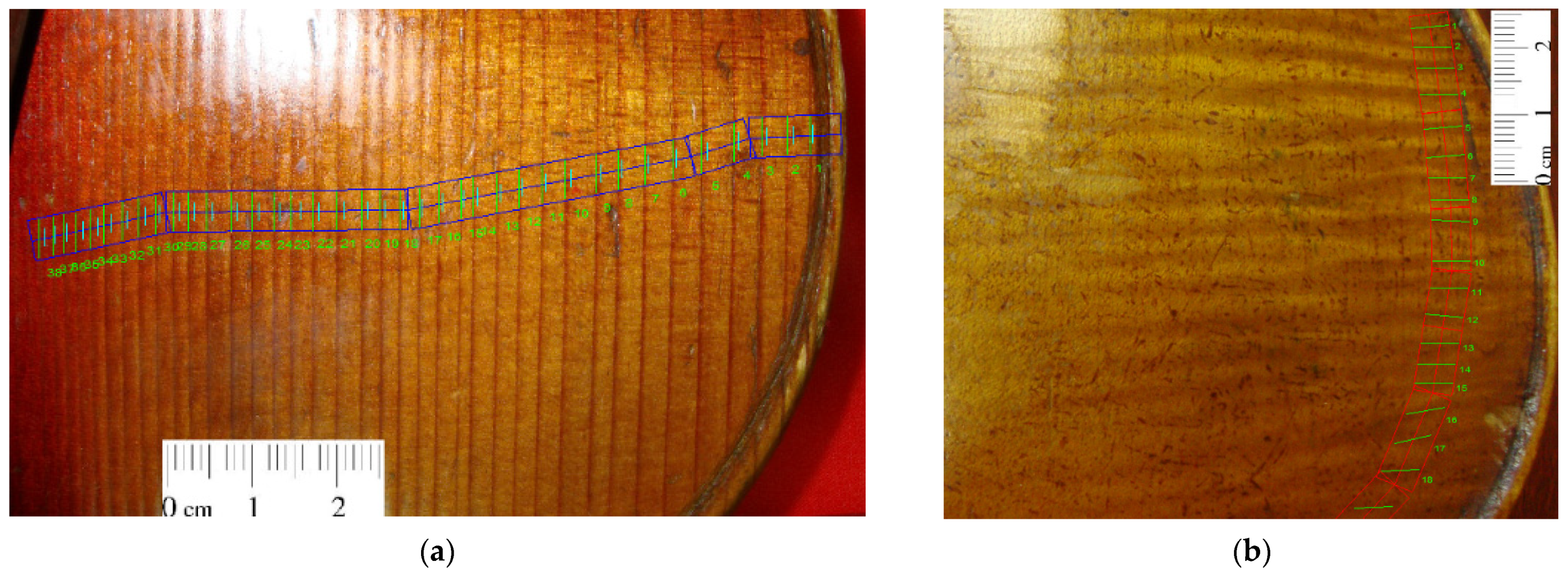
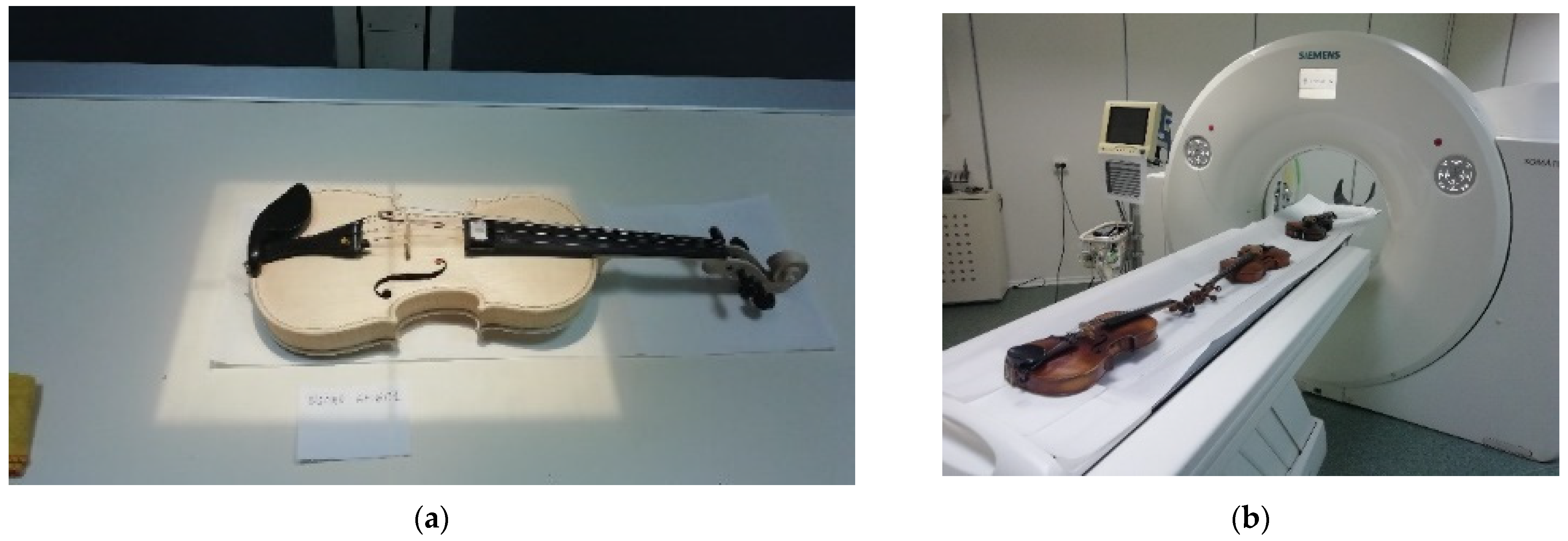
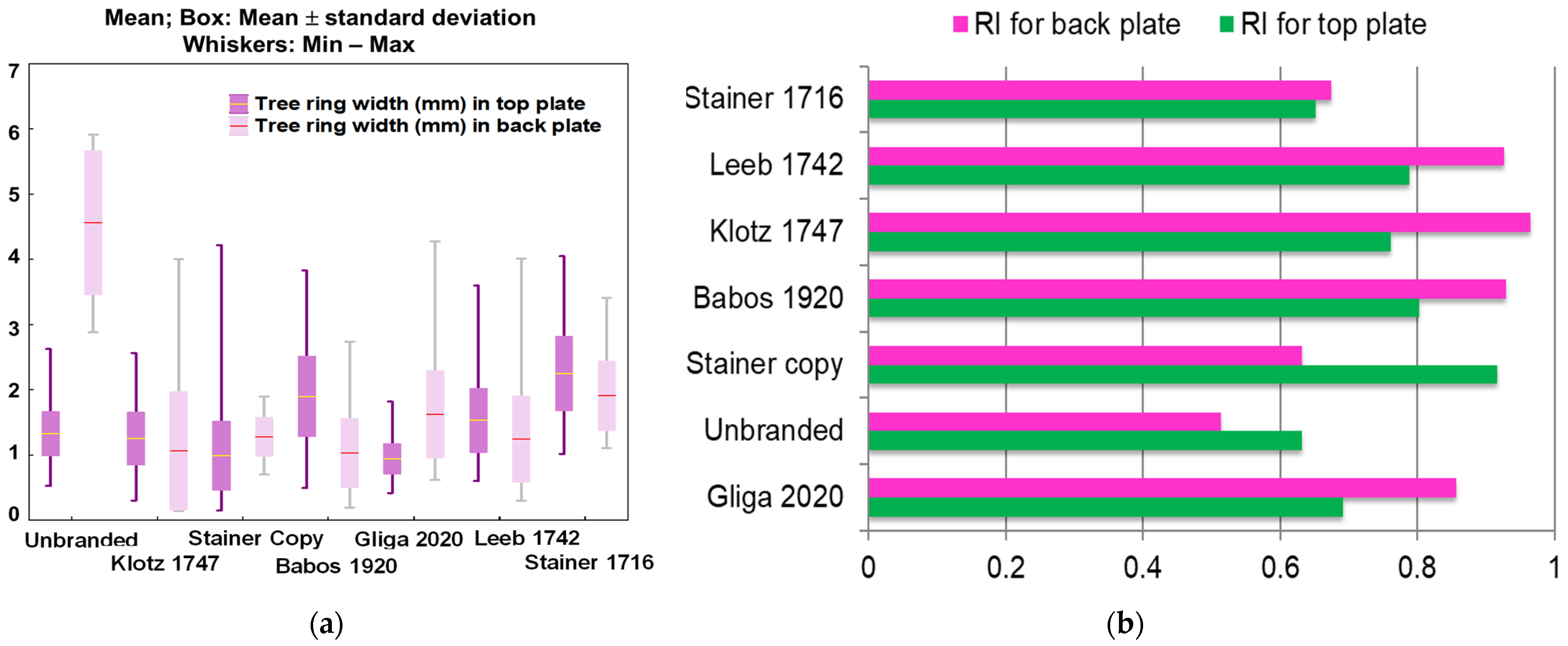
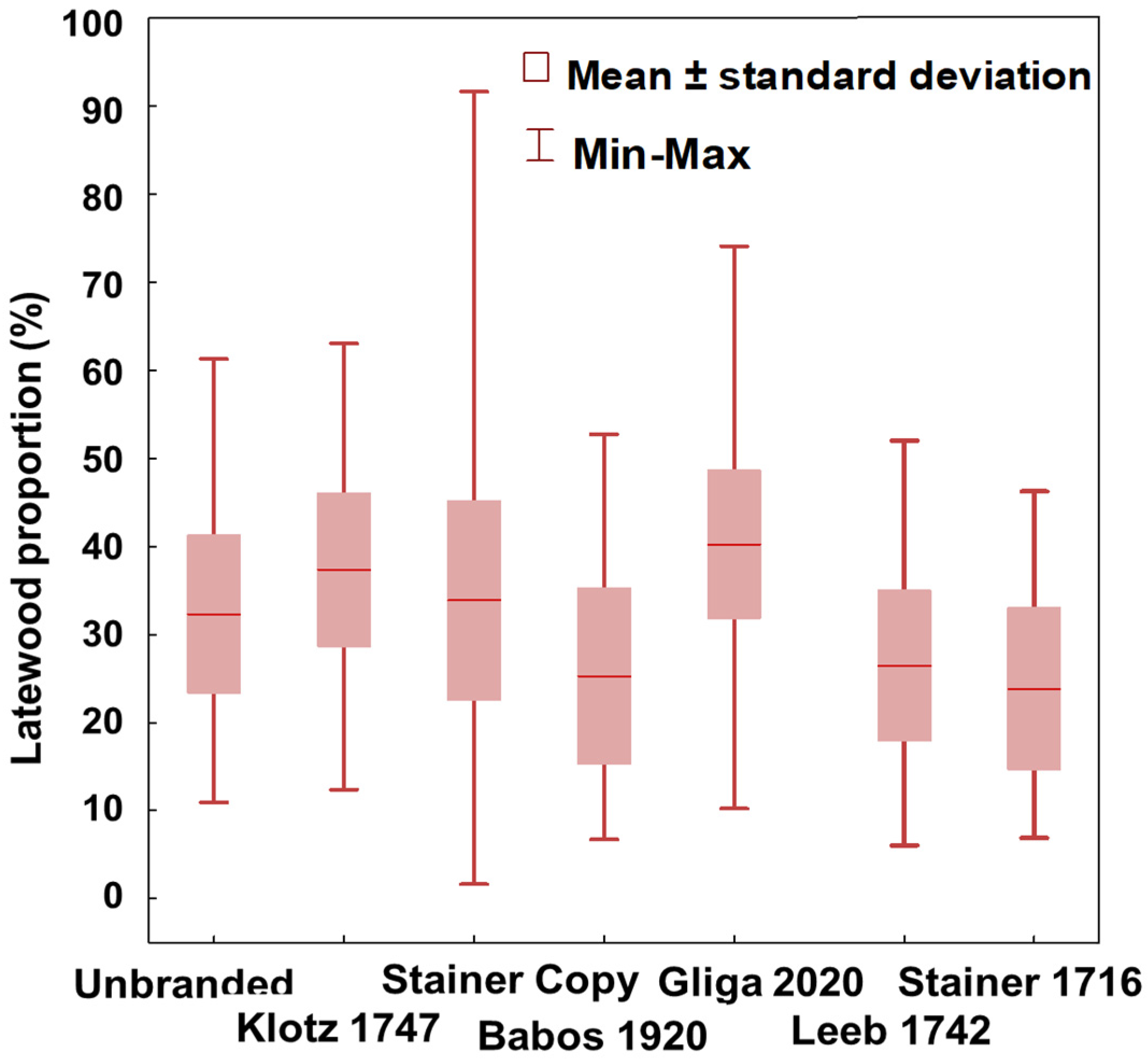
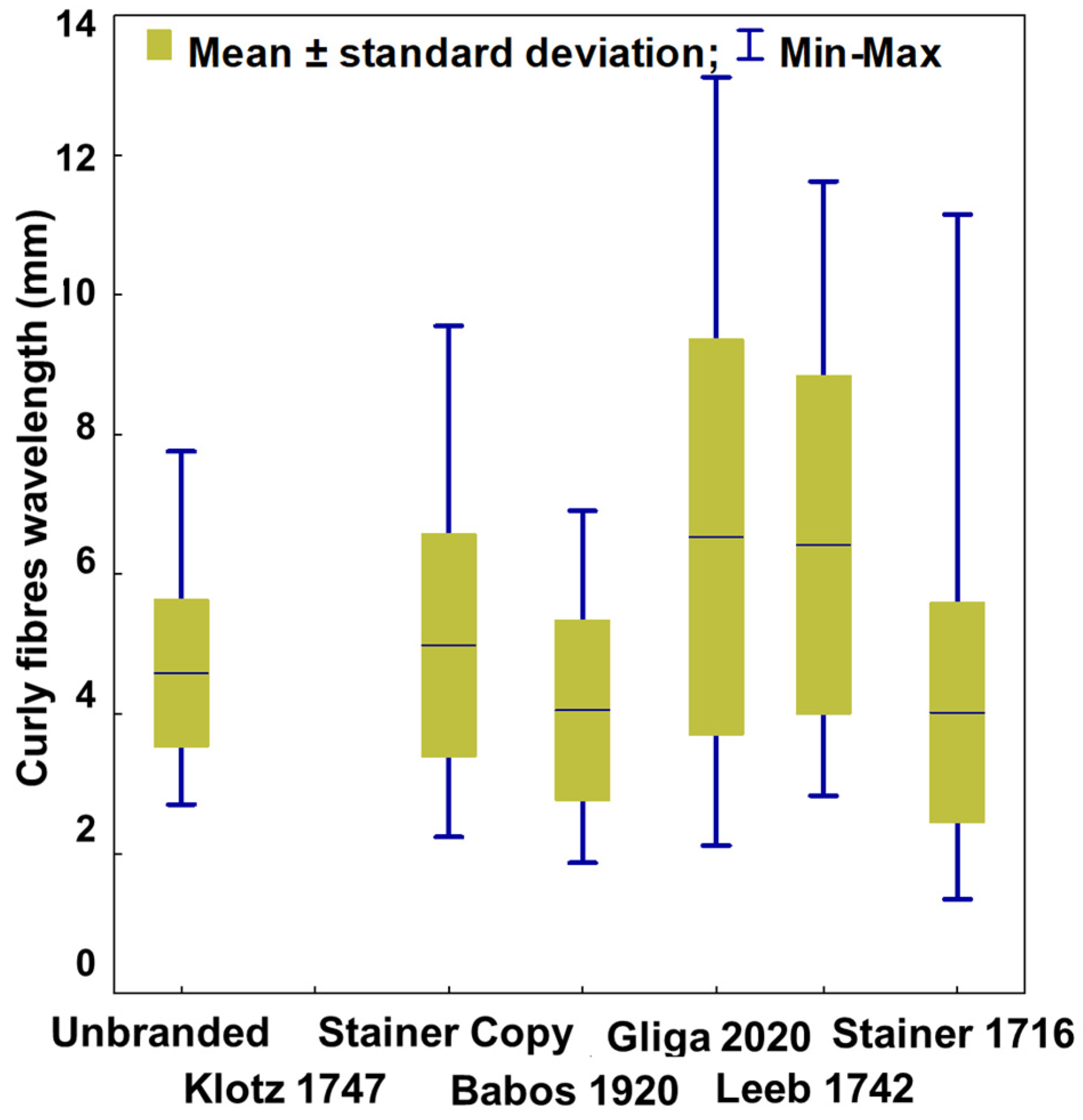
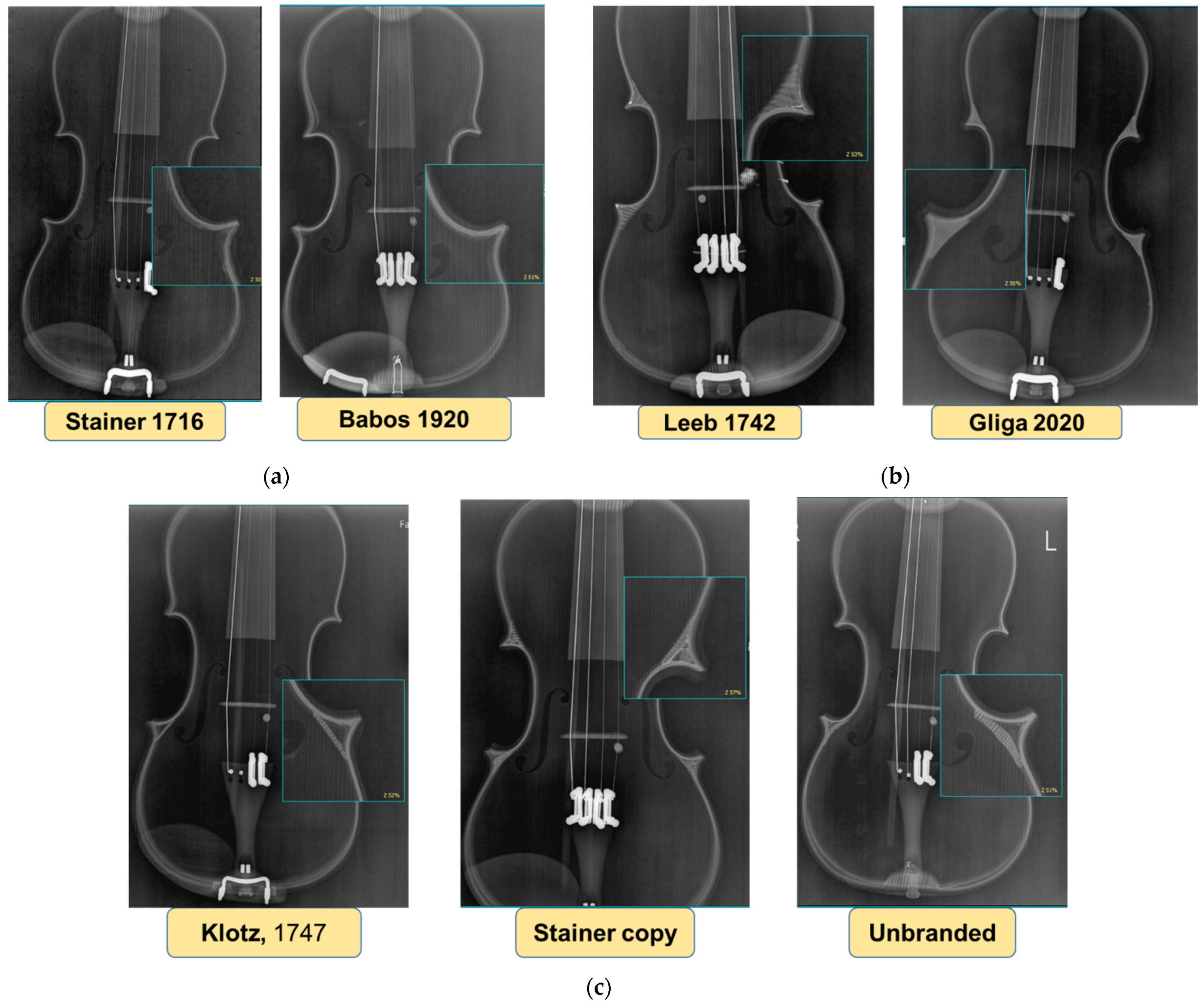
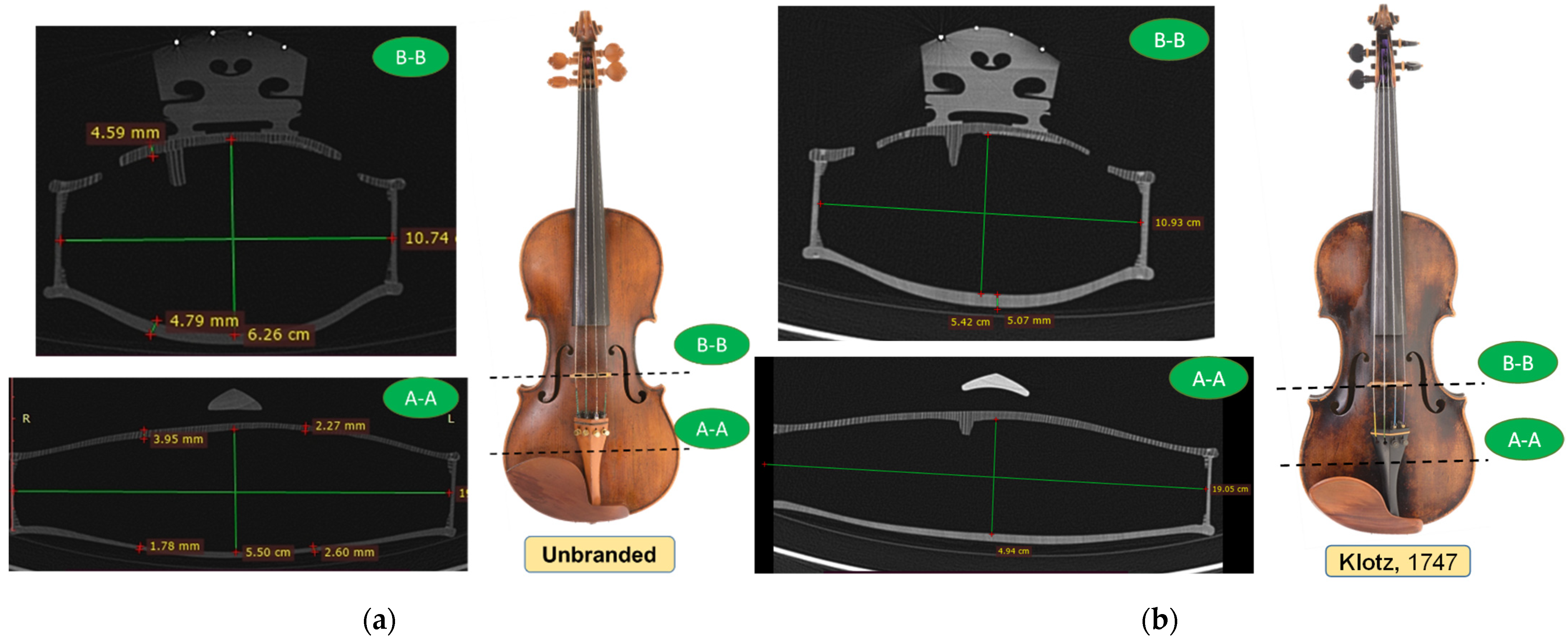
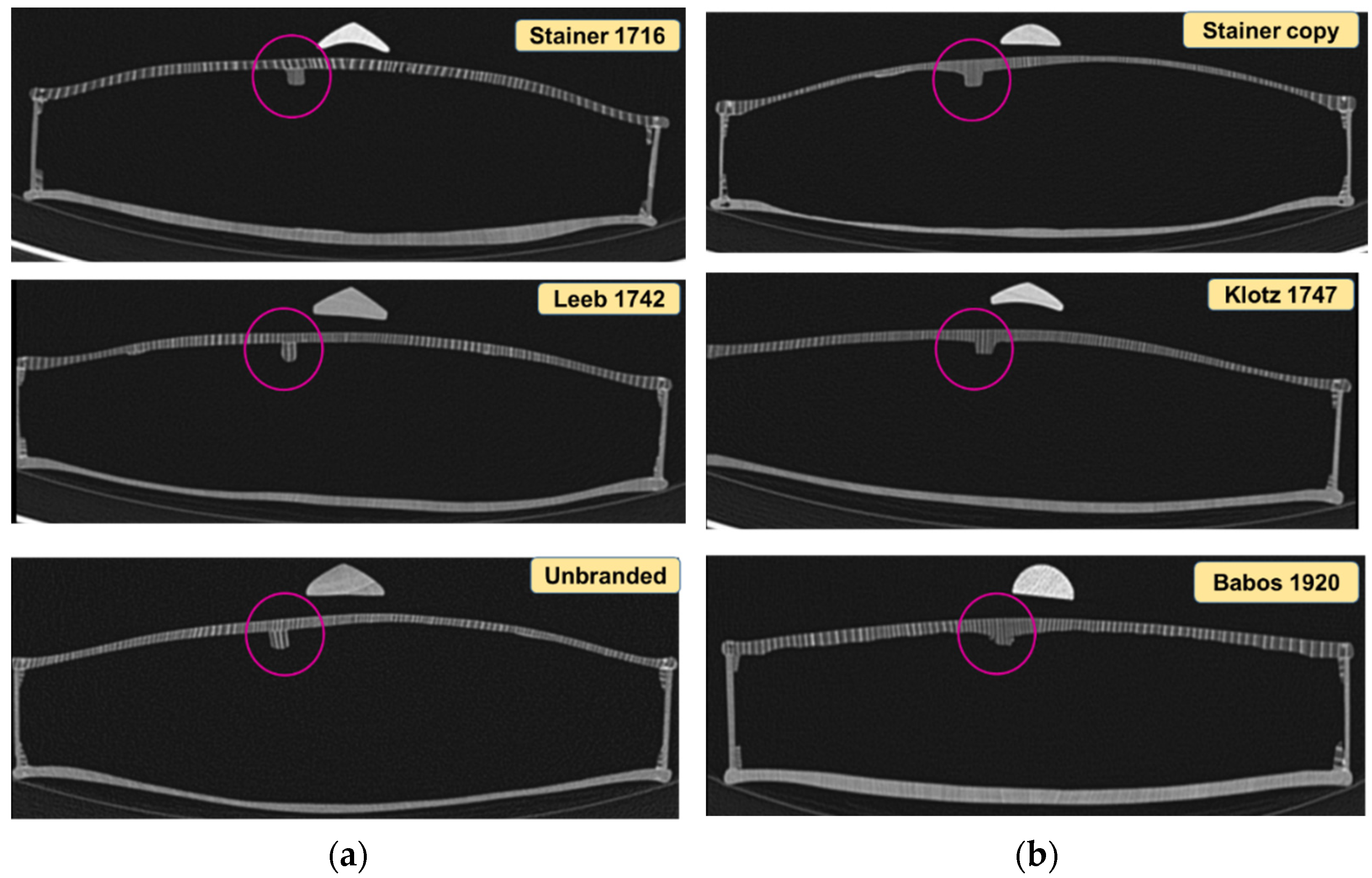
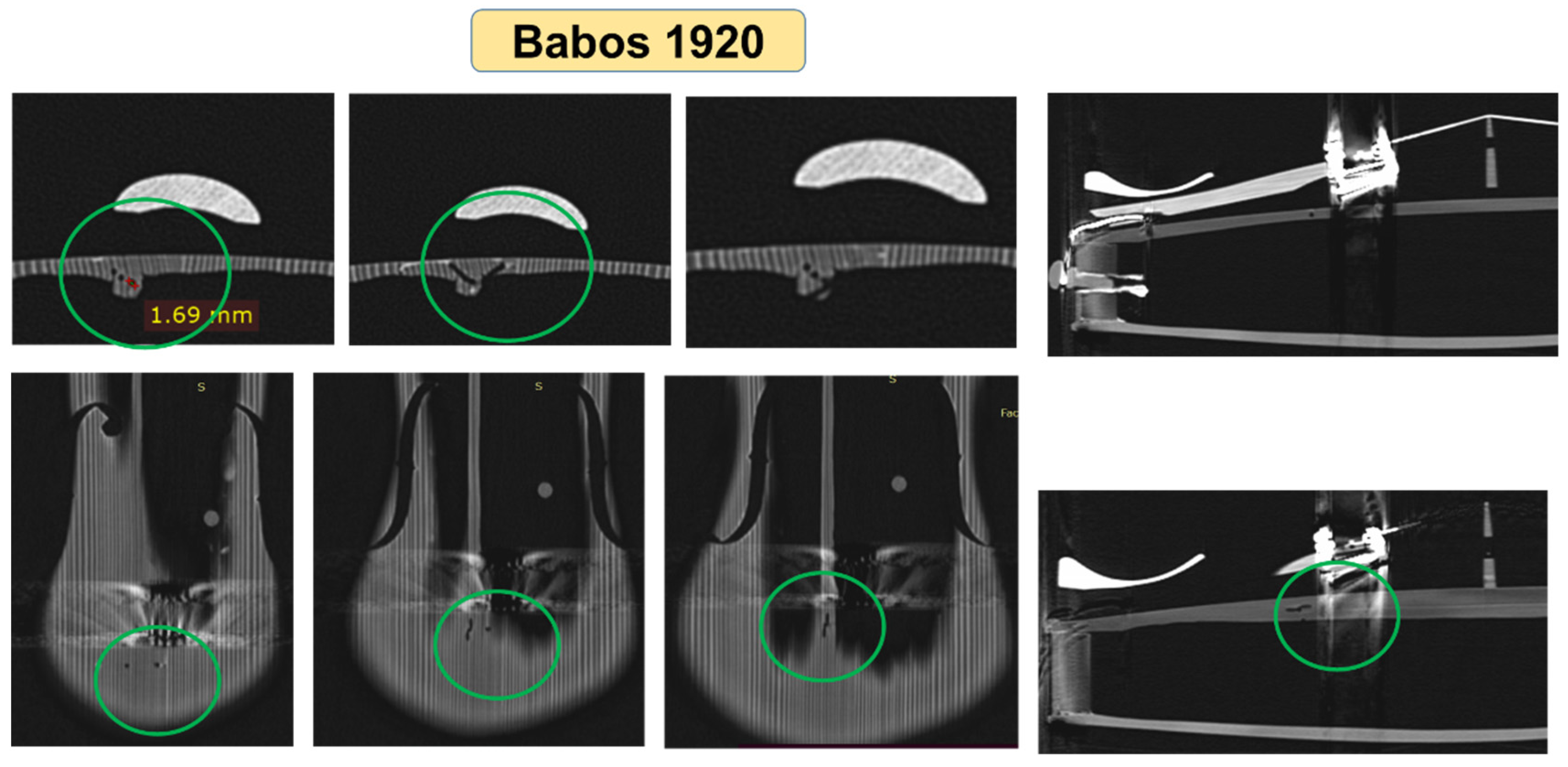
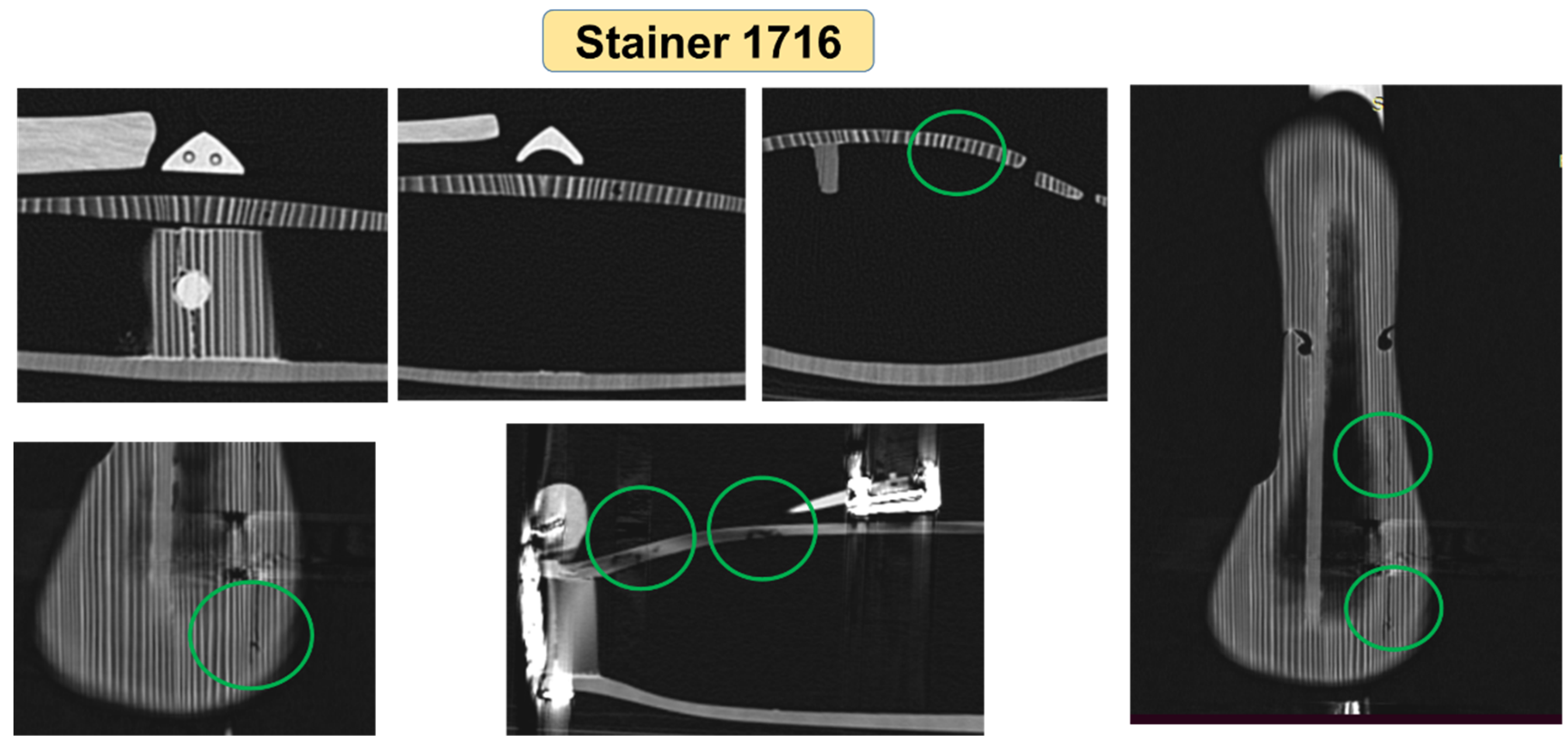
| Variables | Studied Violins | ||||||
|---|---|---|---|---|---|---|---|
| Average Values/STDV | Stainer 1716 | Leeb 1742 | Klotz 1747 | Babos 1920 | Stainer Copy | Unbranded | Gliga 2020 |
| Top Plate (Spruce Wood) | |||||||
| Annual rings widths (mm) | 2.247 | 1.530 | 1.251 | 1.891 | 0.985 | 1.327 | 0.940 |
| 0.567 | 0.490 | 0.403 | 0.612 | 0.527 | 0.336 | 0.234 | |
| Early wood width (mm) | 1.676 | 1.148 | 0.792 | 1.449 | 0.689 | 0.907 | 0.568 |
| 0.518 | 0.467 | 0.304 | 0.601 | 0.450 | 0.293 | 0.190 | |
| Latewood width (mm) | 0.496 | 0.382 | 0.459 | 0.442 | 0.300 | 0.420 | 0.372 |
| 0.178 | 0.122 | 0.162 | 0.158 | 0.118 | 0.130 | 0.100 | |
| Early wood proportion (%) | 76.184 | 73.564 | 62.635 | 74.379 | 66.127 | 67.689 | 59.766 |
| 9.152 | 8.507 | 8.700 | 9.942 | 11.286 | 8.921 | 8.388 | |
| Latewood proportion (%) | 23.816 | 26.436 | 37.365 | 25.203 | 33.873 | 32.311 | 40.234 |
| 9.152 | 8.507 | 8.700 | 9.942 | 11.286 | 8.921 | 8.388 | |
| Back Plate (Maple Wood) | |||||||
| Annual rings widths (mm) | 1.908 | 1.246 | 1.063 | 1.026 | 1.277 | 4.563 | 1.623 |
| 0.531 | 0.658 | 0.902 | 0.527 | 0.297 | 1.105 | 0.666 | |
| Wavelength (mm) | 4.021 | 6.421 | NA | 3.946 | 4.984 | 4.585 | 6.731 |
| 1.577 | 2.422 | NA | 1.256 | 1.589 | 1.057 | 3.371 | |
| Features | Studied Violins | ||||||
|---|---|---|---|---|---|---|---|
| Stainer 1716 | Leeb 1742 | Klotz 1747 | Babos 1920 | Stainer Copy | Unbranded | Gliga 2020 | |
| Types of wood cuts for the violin | Two pieces | Two pieces | One piece | Two pieces | Two pieces | Two pieces | Two pieces |
| Annual rings width | Wide | Narrow | Narrow | Wide | Narrow | Narrow | Narrow |
| Regularity of annual rings | Medium | Weak | Good | Medium | Weak | High | High |
| Symmetry of top plate | Medium | Weak | Medium | Weak | Weak | Medium | High |
| Types of wood cuts for the violin | Two pieces | Two pieces | One piece | Two pieces | Two pieces | Two pieces | Two pieces |
| Annual rings width | Wide | Narrow | Medium | Narrow | Narrow | Wide | Wide |
| Wavelength | Medium curly fibers | Low curly fibers | No curly fiber | Low curly fibers | Medium curly fibers | Medium curly fibers | High curly fibers |
| Regularity of annual rings | Medium | Weak | Weak | Weak | Medium | Medium | Weak |
| Constructive Elements | |||||||
| Type of bass bar | Applied | Applied | From top plate | From top plate | From top plate | Applied | Applied |
| Type of corner | No corners | Solid wood | Softwood slats | No corners | Softwood slats | Softwood slats | Solid wood |
| Coleoptera voids | Yes | No | No | Yes | No | No | No |
Publisher’s Note: MDPI stays neutral with regard to jurisdictional claims in published maps and institutional affiliations. |
© 2021 by the authors. Licensee MDPI, Basel, Switzerland. This article is an open access article distributed under the terms and conditions of the Creative Commons Attribution (CC BY) license (https://creativecommons.org/licenses/by/4.0/).
Share and Cite
Stanciu, M.D.; Mihălcică, M.; Dinulică, F.; Nauncef, A.M.; Purdoiu, R.; Lăcătuș, R.; Gliga, G.V. X-ray Imaging and Computed Tomography for the Identification of Geometry and Construction Elements in the Structure of Old Violins. Materials 2021, 14, 5926. https://doi.org/10.3390/ma14205926
Stanciu MD, Mihălcică M, Dinulică F, Nauncef AM, Purdoiu R, Lăcătuș R, Gliga GV. X-ray Imaging and Computed Tomography for the Identification of Geometry and Construction Elements in the Structure of Old Violins. Materials. 2021; 14(20):5926. https://doi.org/10.3390/ma14205926
Chicago/Turabian StyleStanciu, Mariana Domnica, Mircea Mihălcică, Florin Dinulică, Alina Maria Nauncef, Robert Purdoiu, Radu Lăcătuș, and Ghiorghe Vasile Gliga. 2021. "X-ray Imaging and Computed Tomography for the Identification of Geometry and Construction Elements in the Structure of Old Violins" Materials 14, no. 20: 5926. https://doi.org/10.3390/ma14205926
APA StyleStanciu, M. D., Mihălcică, M., Dinulică, F., Nauncef, A. M., Purdoiu, R., Lăcătuș, R., & Gliga, G. V. (2021). X-ray Imaging and Computed Tomography for the Identification of Geometry and Construction Elements in the Structure of Old Violins. Materials, 14(20), 5926. https://doi.org/10.3390/ma14205926







